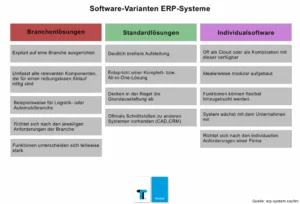An enterprise resource planning system (ERP for short) is used in many companies of different sizes. It helps start-ups, medium-sized companies, and large corporations alike to make many business processes more efficient. This is achieved through effective planning and optimization of all available resources. However, before an ERP system can be implemented in a company’s IT infrastructure, company-specific requirements must be met – here are the five most important questions and answers to consider when making your selection.
What functions must an ERP system have?
Basically, ERP software can be divided into core and additional modules. The following core components should be included in the ERP standard:
-
- Accounting: Accounting is the be-all and end-all of a company that wants to be successful in the long term. Invoices must be written, salaries paid, and incoming and outgoing payments meticulously documented. This is the only way to ensure that a cash basis accounting system or annual financial statements and balance sheet are ultimately guaranteed. An ERP system helps companies to centralize activities in one program. Thanks to integrated templates and a single click, it is easy to transfer wages or salaries and send invoices/orders.
- Logistics: Fast delivery of orders is now standard – not only for consumers in retail, but also for business customers whose production depends on another company delivering the necessary resources on time and in full. The digitalization of logistics is therefore becoming increasingly important. Automated processes and a permanent overview of capacity utilization ensure planning reliability.
- Inventory management: Depleted resources (see also opportunity costs), bottlenecks, or delivery problems cost a company more than just money. In online retail in particular, such situations can lead to the loss of important customers. They expect the goods they want to be available anytime, anywhere. If this is not the case, they will look for another supplier who can satisfy their needs. This is where the inventory management system comes in. Among other things, it is responsible for replenishing materials or goods so that production or sales do not come to a standstill (see also Replenishment in intralogistics).
- Human resources: Employees are an important resource in a company. If someone is absent, they must be replaced as quickly as possible. If too few employees have been assigned to a task, this can lead to delays in the worst case. It is therefore essential that responsible employees are always and everywhere up to date on whether sufficient manpower is available to master all pending tasks.
- Production: A manufacturing company must be able to filter process flows within production in a broken-down manner:
- – Are sufficient materials available to guarantee smooth operations and prevent bottlenecks?
- – Are there delays or disruptions at individual points in the production line?
- – Are enough employees available to operate the machines if necessary, or are there any absences that need to be compensated for?
Many manufacturers/suppliers also offer the option of adding additional functions on an individual basis. These can include:
-
-
- Sales
- CRM
- E-commerce
- Marketing
-
Editor’s note: However, it is important that companies are clear about what they really need and what might be useful later on.
Customized, industry-specific, or standard solutions?
Those who decide to implement an ERP system are often spoiled for choice. There are a large number of providers and an even larger selection of software solutions. It is therefore important to first work out your own requirements. These can then be used to make a sustainable purchase decision. The range usually includes customized, industry-specific, and standard solutions (see image below):

In addition, there are special forms, such as a functional ERP system, which only cover certain areas within a company. Appropriate accounting programs or software modules for quality assurance are often used.
The decision should never be made lightly. Every variant of an ERP system can be interesting for a company, regardless of its size or number of employees. As a rule, the budget is the deciding factor:
-
-
- A standard solution is well suited, for example, for companies that do not have a specific focus and therefore do not need additional features. Since this ERP model includes all the basic components, it is very easy to work with.
- For start-ups, an all-in-one solution can be useful, especially in the beginning, because it is cheaper to implement than customized system environments, for example. At the same time, cloud ERPs are also interesting because young companies can customize the functions to their specific requirements. In addition, neither hardware nor IT specialists are required. Since most start-ups have a limited budget, cloud ERPs make a lot of sense.
- Large corporations usually opt for customized software. This is generally best suited to their requirements, as existing structures are significantly more complex than those of SMEs. Although customized programs involve significantly higher costs, large corporations also require a wider range of functions.
-
What costs are incurred during implementation?
The more preparatory work a company does, the cheaper the ERP system will be. If you clearly formulate your requirements from the outset and send them to the provider in the form of a requirements or specifications document, the more specifically the development can take customer wishes and technical details into account. As a rule, this also makes it easier to identify hidden costs and discuss them before the actual development phase. At the same time, the type of ERP system is of course relevant. Customized software is always more expensive than the all-in-one version.
Many companies also forget the ongoing costs associated with implementation. Those who opt for an on-premise version, i.e., a usage and licensing model, will need IT specialists and the appropriate hardware, among other things. The company is also responsible for support and maintenance. With an ERP system implemented in the cloud, the costs are not eliminated, but the provider’s surcharge can be cheaper in the long term thanks to subscriptions. The manufacturer is responsible for support and updates. No additional hardware is required.
In general, it can be assumed that implementation costs are very individual. It is therefore difficult to provide an accurate breakdown of expenses—every situation and set of requirements is different, as are the needs and requirements of the companies concerned. However, the following general statements can be made:
-
-
- The acquisition costs are around $6,000 per workstation.
- If no hardware is required, the price is lower.
- Individual requirements and additional features will increase the costs.
- Of course, implementation and subsequent activities also require human resources. Companies should plan for between four and seven employees.
- In addition, two to three external experts are required.
- Modernization, maintenance, and updates also cost money. These can be estimated at around one-third of the acquisition costs. The ERP system should be checked for updates at least every five years.
- Implementation can easily take up to twelve months.
-
How important is usability?
User-friendliness is an essential criterion when selecting an ERP system. The easier the software is to use, the easier it will be for employees to learn. Intuitive operation also reduces the amount of work required.
The interface is one of the factors that affects usability. It should not appear too cluttered. The faster users can find the function they need, the more efficiently they can work with the software. Clear and easy navigation is therefore recommended. Help functions integrated into the ERP software can also be useful, for example, by clearly explaining individual processes.
Companies that opt for cloud ERP also have the advantage that users are not tied to an office or the company network. Instead, access is possible worldwide – in addition to a stable internet connection, VPN access to the company network is required, and the cloud ERP solution must be GDPR-compliant.
What about data protection?
Since the aforementioned GDPR came into force, the protection of personal data has become a top priority. Many companies are uncertain about this, especially in the field of cloud ERP. When choosing an ERP system, it is therefore important to pay attention to the provider’s location. The new GDPR states that both European and other countries must comply with data protection guidelines. Nevertheless, these often differ, especially when comparing the EU and third countries such as the US. If questions arise, it is always advisable to contact the responsible data protection officer and check whether the data of customers, employees, and partners is really secure in the system. If a company does not want to take any risks, it can also implement its systems locally and integrate them into the IT infrastructure of the respective system – access is then either local via the network or via a VPN connection.
